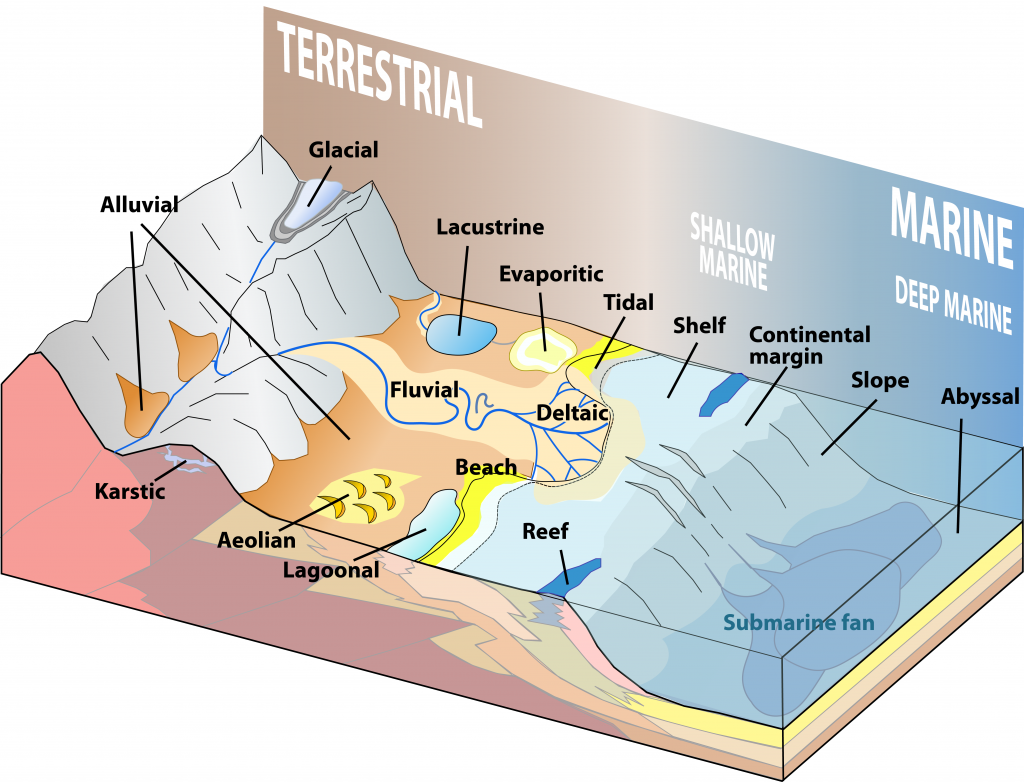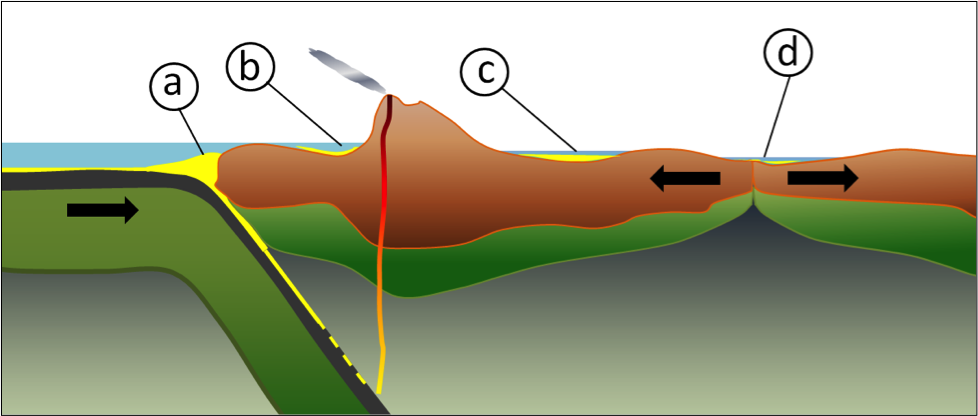9.4 Depositional Environments and Sedimentary Basins
The setting in which sediments are accumulated is called a depositional environment. (Some of the more important of these environments are illustrated in Figure 9.19.) Thus far you’ve seen that some types of sedimentary rocks—coal, and gypsum, for example—require very specific conditions to form because particular biological processes or chemical reactions are necessary. Different types of clastic sedimentary rocks also form in particular depositional environments. In the case of clastic rocks, the key environmental conditions are related to the amount of energy available to transport sediments, and how far the sediments get from their source before being deposited.
Broadly, depositional environments can be said to be terrestrial, marine, or to reflect a transitional zone between the two. Terrestrial refers to depositional environments on land. These may be depositional environments such as deserts, found on dry land, but they could also be environments such as freshwater lakes or rivers. Marine refers to environments associated with saltwater seas and oceans. Transitional depositional environments include environments such as deltas, where freshwater rivers empty into saltwater seas or oceans.

Tables 9.1 and 9.2 provide a summary of the processes and sediment types that pertain to the various depositional environments illustrated in Figure 9.19. The types of sediments that accumulate in these environments are examined in more detail in the last section of this chapter.
| Table 9.1 Terrestrial Depositional Environments | |||
| Environment | Key Transport Processes | Depositional Settings | Typical Sediments |
|---|---|---|---|
| Glacial | Gravity, moving ice, moving water | Valleys, plains, streams, lakes | Glacial till, gravel, sand, silt, clay |
| Alluvial | Gravity, moving water | Where steep-sided valleys meet plains | Coarse angular fragments |
| Fluvial | Moving water | Streams | Gravel, sand, silt, organic matter |
| Aeolian | Wind | Deserts and coastal regions | Sand, silt |
| Lacustrine | Moving Water | Lakes | Sand, silt, clay, organic matter |
| Evaporite | Still water | Lakes in arid regions | Salts, clay |
| Source: Karla Panchuk (2018), CC BY 4.0. Modified after Steven Earle (2015), CC BY 4.0. View source.. | |||
| Table 9.2 Marine & Transitional Depositional Environments | |||
| Environment | Key Transport Processes | Depositional Settings | Typical Sediments |
|---|---|---|---|
| Deltaic | Moving water | Deltas | Sand, silt, clay, organic matter |
| Beach | Waves, long-shore currents | Beaches, spits, sand bars | Gravel, sand |
| Tidal | Tidal currents | Tidal flats | Fine-grained sand, silt, clay |
| Reef | Waves, tidal currents | Reefs and adjacent basins | Carbonates |
| Shallow marine | Waves, tidal currents | Shelves, slopes, lagoons | Carbonates in tropical climates; sand/silt/clay elsewhere. |
| Lagoonal | Little transportation | Lagoon bottom | Carbonates in tropical climates, silt, clay |
| Submarine fan | Underwater gravity flows | Continental slopes, abyssal plains | Gravel, sand, silt, clay |
| Deep water | Ocean currents | Deep-ocean abyssal plains | Clay, carbonate mud, silica mud |
| Source: Karla Panchuk (2018), CC BY 4.0. Modified after Steven Earle (2015), CC BY 4.0. View source.. | |||
Sedimentary Basins Are Needed to Collect Sediment
Most of the sediments that you might see around you, including talus on steep slopes, sand bars in streams, or gravel in road cuts, will never become sedimentary rocks. This is because they’ve only been deposited relatively recently—perhaps a few centuries or millennia ago—and will be re-eroded before they are buried deep enough beneath other sediments to be lithified. In order for sediments to be preserved long enough to be turned into rock (a process that takes millions or tens of millions of years) they need to have been deposited in a basin in which sediments can be preserved for that long. Most such basins are formed by plate tectonic processes (Figure 9.20).

Trench basins form where a subducting oceanic plate dips beneath the overriding continental or oceanic lithosphere. They can be several kilometres deep, and in many cases, host thick sequences of sediments from nearby eroding coastal mountains. There is a well-developed trench basin off the west coast of Vancouver Island.
A forearc basin lies between the subduction zone and the volcanic arc, and may be formed in part by friction between the subducting plate and the overriding plate, which pulls part of the overriding plate down. The Strait of Georgia, the channel between Vancouver Island and the BC mainland, is a forearc basin.
A foreland basin is caused by the mass of a mountain range depressing the crust. A rift basin forms where continental crust is being pulled apart, and the crust on both sides the rift subsides. If rifting continues this will eventually becomes a narrow sea, and then an ocean basin. The East African rift basin represents an early stage in this process.
Sedimentary Records of Sea-Level Change
Sea level is constantly changing. While the amount of water on Earth doesn’t vary, the form that water takes does change. During ice ages, water that evaporates from oceans can become trapped on land if the water precipitates as snow and becomes part of a glacier. Over time, accumulating water as glacial ice would lower sea level globally. Conversely, when the ice melts, the water flows back to the ocean and sea level will rise. Note that while melting glaciers on land will cause sea level to rise, melting ice in the ocean will not. When sea ice melts, the volume of ice is simply traded for an equal volume of water, so there’s no net change in the volume of the ocean
A second mechanism for raising sea level is a higher rate of ocean crust formation along seafloor spreading centres. The hot new crust floats higher in the mantle because it has a lower density than older crust. When there’s more new crust than usual, this has an effect similar to adding rocks to a bucket of water. The increased volume of new crust displaces water, causing sea level to rise.
A third mechanism changing sea level is changing global average temperatures. Warming decreases the density of water and increases its volume. Cooling increases density and decreases volume.
The implication of sea-level change for depositional environments is that the depositional environment will change. A terrestrial depositional environment such as a river might be flooded with seawater to a great depth. Sedimentary rocks that accumulated after the flooding would reflect a marine depositional environment rather than a terrestrial one. Looking back in the geologic record, if we were to find sedimentary rocks indicating a river depositional environment, and above those, rocks indicating a marine environment, we would know that sea level rose.
Eustatic or Relative?
Sea level change caused by an increase or decrease in the overall volume of water in the ocean is called eustatic (yoo-sta′-tic) sea-level change. However, sometimes sediments can record a change in sea level even when the ocean as a whole does not change in volume. An example would be if uplift due to mountain building raises a region above sea level. Apparent sea-level change resulting from a change in land elevation is called relative sea-level change.

